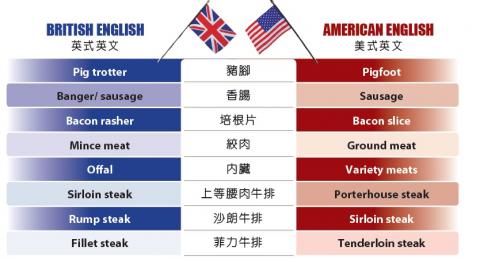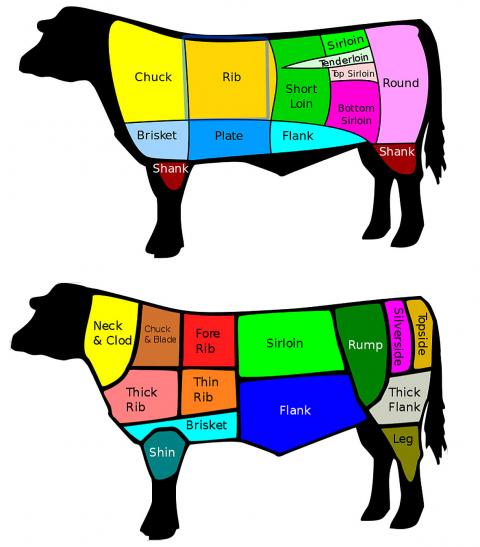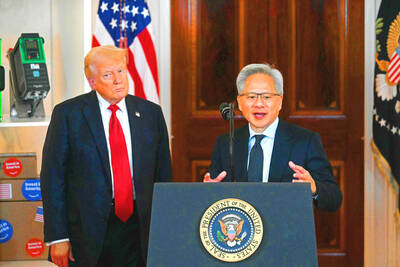“Gimme a pigfoot and a bottle of beer,” sang US blues singer Bessie Smith in 1933. Had she been in the UK she would probably have sung, “Gimme a pig trotter and a bottle of beer.” Both work, in terms of the lyric and as a description of the food. Pig trotter can be used in US English; pigfoot doesn’t really work in British English. There are many differences between American and British English when describing food. We have sausages on both sides of the “pond,” but in the UK they are also called “bangers,” possibly because they pop in the frying pan when the skin blisters in the hot oil. There are others: ground beef is called mince beef in the UK; variety meats (edible organs such as kidney, heart and liver) are referred to as offal in the UK; and a slice of bacon is known as a rasher in British English.
Cuts of meat are another case in point. Sirloin is used in both countries, but for slightly different parts of the cow. The word derives from the old French surloigne, meaning “above the loins.” The loins are both sides of the spine between the lowest ribs and the hip bones. In British English, the sirloin cut comes from a section quite far forward on the loin; in American English, this part is known as the short loin, from where porterhouse steak is cut. The US sirloin and tenderloin steaks are cut from further back on the animal, from what is called the rump in British English.
(Paul Cooper, Taipei Times)

「Gimme a pigfoot and a bottle of beer」(給我一隻豬腳和一瓶啤酒),美國藍調歌手貝西‧史密斯在她一九三三年的歌中如此唱道。如果她身在英國,她的歌詞可能會是這樣:「Gimme a pig trotter and a bottle of beer」。這兩種版本都對,無論是就歌詞或食物名稱而言。英式的「pig trotter」在美式英文中也通用;但美式的「pigfoot」在英式英文中卻不太行得通。食物的名稱在美式和英式英文中有許多差異。「sausage」(香腸)一字是英美通用,但在英國也叫做「banger」(原意為發出鞭炮聲的東西),這或許是因為煎鍋中的香腸,其外皮會因熱油而起泡、爆開來。其他的不同還包括:美式的「ground beef」(牛絞肉)在英式英文中叫做「mince beef」,內臟(腎臟、心臟、肝臟等可食用的動物器官)的美式英文是「variety meats」,英式英文叫做「offal」。培根肉(bacon)薄片在英式英文中則叫做「rasher」。
肉排的名稱與部位又是另一個例子。「sirloin」(沙朗)一字英美皆使用,但所指牛的部位略有不同。它源於古法語字「surloigne」,意為「腰部上方」。「loin」(腰肉)指的是介於最低的肋骨和髖骨之間脊椎兩側的肉。英式英文的「sirloin」指的是腰肉較前面的部位,但這部分的肉在美式英文中是叫做「short sirloin」,也是上等腰肉牛排(porterhouse steak)所取用的部位。美式英文的「sirloin」及「tenderloin」(牛柳/里脊肉),是指牛身更靠後方的肉,也就是英式英文所稱的「rump」(牛臀肉)。
(台北時報林俐凱譯)

Photo: Wikimedia Commons
照片:維基共享資源

Long before numerals and arithmetic systems developed, humans relied on tally marks to count. These simple, repeated marks — often just straight lines — are one of the earliest and most widespread methods of recording numbers. Archaeological findings suggest that humans began tallying in prehistoric times. During the Late Stone Age in Africa, humans began to carve notches onto bones to create tangible records of quantities. One of the earliest known examples is the Wolf bone, an artifact unearthed in Central Europe in 1937. This bone bears notches believed to be an early form of counting. Even more intriguing

A: In addition to Teng Kai-wei, Taiwanese infielder Cheng Tsung-che was called up temporarily to play for the Pittsburgh Pirates in early April. B: Yeah, Cheng is the 18th player in Taiwan’s baseball history to be moved up to the majors. A: Back in 2002, Chen Chin-feng became the first Taiwanese to play in the Major League Baseball (MLB), followed by Tsao Chin-hui, Wang Chien-ming, Kuo Hung-chih, Hu Chin-lung and Lin Che-hsuan. B: Those pioneers were later joined by Lo Chia-jen, C.C. Lee, Ni Fu-te, Chen Wei-yin, Wang Wei-chung, Hu Chih-wei, Tseng Jen-ho, Lin Tzu-wei, Huang Wei-chieh, Yu Chang,

When Nvidia CEO Jensen Huang revealed on Friday last week that the company is working with the Trump administration on a new computer chip designed for sale to China, it marked the latest chapter in a long-running debate over how the US should compete with China’s technological ambitions. The reasoning has sometimes changed — with US officials citing national security, human rights or purely economic competition — but the tool has been the same: export controls, or the threat of them. Nvidia believes it can eventually reap US$50 billion from artificial intelligence (AI) chip sales in China. But it so far has

Continued from yesterday(延續自昨日) https://www.taipeitimes.com/News/lang In many Western countries, the most common form of tally marks employs a five-bar gate structure: four vertical lines followed by a diagonal slash. To form this group, one begins by drawing four parallel vertical lines, each representing one. For the fifth, draw a diagonal line across the existing four. This diagonal stroke effectively creates a distinct group of five. To continue counting, just initiate a new cycle in the same manner. A set of five tallies combined with a single vertical line next to it represents the number six. Across many Asian countries, the Chinese character